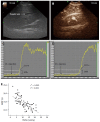Invasive and non-invasive diagnosis of cirrhosis and portal hypertension
- PMID: 24764667
- PMCID: PMC3989965
- DOI: 10.3748/wjg.v20.i15.4300
Invasive and non-invasive diagnosis of cirrhosis and portal hypertension
Abstract
With advances in the management and treatment of advanced liver disease, including the use of antiviral therapy, a simple, one stage description for advanced fibrotic liver disease has become inadequate. Although refining the diagnosis of cirrhosis to reflect disease heterogeneity is essential, current diagnostic tests have not kept pace with the progression of this new paradigm. Liver biopsy and hepatic venous pressure gradient measurement are the gold standards for the estimation of hepatic fibrosis and portal hypertension (PHT), respectively, and they have diagnostic and prognostic value. However, they are invasive and, as such, cannot be used repeatedly in clinical practice. The ideal noninvasive test should be safe, easy to perform, inexpensive, reproducible as well as to give numerical and accurate results in real time. It should be predictive of long term outcomes related with fibrosis and PHT to allow prognostic stratification. Recently, many types of noninvasive alternative tests have been developed and are under investigation. In particular, imaging and ultrasound based tests, such as transient elastography, have shown promising results. Although most of these noninvasive tests effectively identify severe fibrosis and PHT, the methods available for diagnosing moderate disease status are still insufficient, and further investigation is essential to predict outcomes and individualize therapy in this field.
Keywords: Hepatic fibrosis; Hepatic venous pressure gradient; Liver biopsy; Non-invasive test; Portal hypertension; Transient elastography.
Figures



References
-
- Marcellin P, Gane E, Buti M, Afdhal N, Sievert W, Jacobson IM, Washington MK, Germanidis G, Flaherty JF, Schall RA, et al. Regression of cirrhosis during treatment with tenofovir disoproxil fumarate for chronic hepatitis B: a 5-year open-label follow-up study. Lancet. 2013;381:468–475. - PubMed
-
- Schalm SW. The diagnosis of cirrhosis: clinical relevance and methodology. J Hepatol. 1997;27:1118–1119. - PubMed
-
- Friedman SL, Bansal MB. Reversal of hepatic fibrosis -- fact or fantasy? Hepatology. 2006;43:S82–S88. - PubMed
-
- Bravo AA, Sheth SG, Chopra S. Liver biopsy. N Engl J Med. 2001;344:495–500. - PubMed
-
- Bosch J, Abraldes JG, Berzigotti A, García-Pagan JC. The clinical use of HVPG measurements in chronic liver disease. Nat Rev Gastroenterol Hepatol. 2009;6:573–582. - PubMed
Publication types
MeSH terms
LinkOut - more resources
Full Text Sources
Other Literature Sources
Medical

